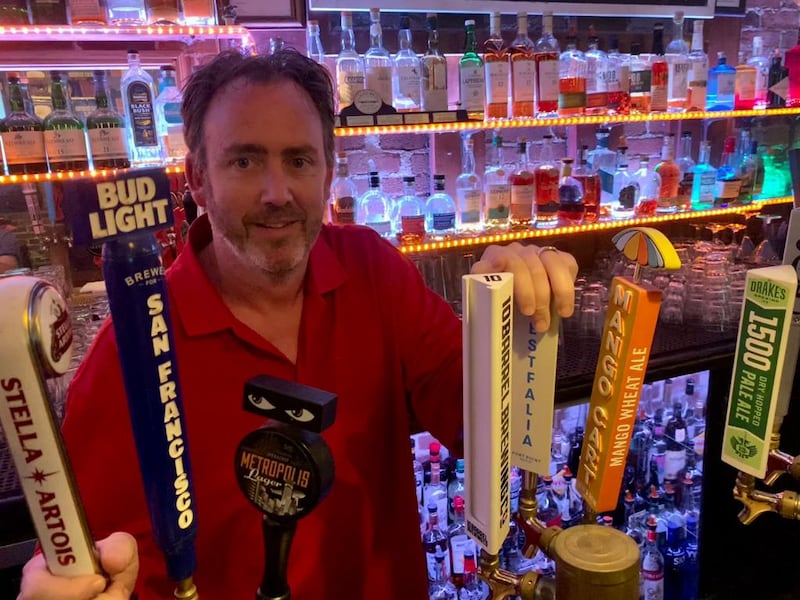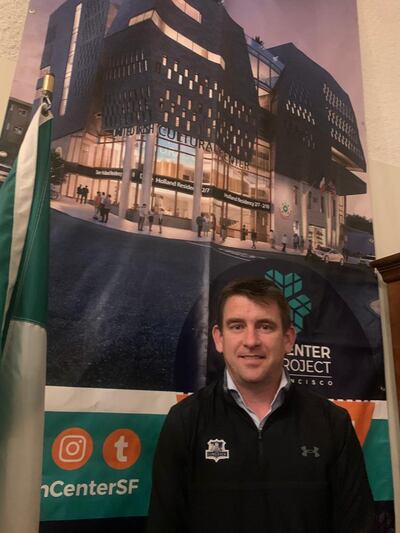As thousands of Irish students look forward to this year’s J1 Visa exodus to the United States in the coming weeks, the advice from there is simple: prepare, prepare and then make sure you are prepared.
“The more you prepare, the better the time you will have here,” says Aileen Leonard, the New York-based executive director of the Coalition of Irish Immigration Centers (CIIC). “The key takeaway is to be prepared, be smart and have fun. The more preparation students have coming in, the smoother ... the time spent in the US will be.”
No one who knows anything about how the US works and what to tell students going there for a few summer months – to earn some money and have a good time – disagrees.
“Be prepared,” says Celine Kennelly, director of the Irish Immigrant Pastoral Centre, the San Francisco affiliate of CIIC. “A lot of Irish students come by the seat of their pants with little or no idea where they are going to stay in the first few days when they arrive.”
READ MORE
A word of caution, however. The hospitality sector may not be the easy access to work it once was. Post Covid, US hospitality, like many other places, remains a bit in the doldrums.
“We’re at about 60 to 65 per cent of what we were doing before Covid,” says Ronan O’Neill of The Irish Bank, a pub in downtown San Francisco that pulls in trade from the financial district and also Union Square, with its shops and cable car terminus popular with tourists.

As of now, they won’t be taking in any J1 student workers this year. The pub received “probably 300 emails” from Irish students looking for summer work but hasn’t been able to send a yes back to any.
“Pre-Covid, we had 24 staff but now we’re still at 16,” says O’Neill. “There’s barely enough work to keep our own guys going.”
The pub can handle more than 200 patrons at a time (including 100 at tables in a side lane off Cyril Magnin Street) but, says O’Neill, “for 27 years, Friday was our busiest day but now, some Sundays are busier”.
The good news for students who do go to the US (and for their parents) is that there are numerous sources of sound advice about the J1 programme – how to work it and how to get the best out of it. They include the Department of Foreign Affairs, the Union of Students in Ireland (USI) and the networks of Irish centres in the US, which are part funded by the Government.
The CIIC has affiliates across the US – including New York, Boston, Philadelphia, Chicago, Seattle, San Diego and San Francisco -, each of which may be accessed online and can assist in making plans.
If you get a job, show up for work – don’t be taking the p***
— Liam Reidy of the United Irish Cultural Center of San Francisco
Government and USI advice literature can also be found online, and these days, that advice includes urgings to be a good ambassador for Ireland. In other words, behave well or, as a new pamphlet from the CIIC puts it, “follow the rules, be respectful of neighbours ... [and] have fun”.
Advice to students comes under various headings but the starting point is to hook up with a cultural exchange agent in Ireland. The best way to do this is through Usit, who will advise and facilitate your visa application.
In the US, students need to have a sponsor – a person who will be their link with the US authorities. By going the official route and getting a J1, which will be issued through the US embassy, a student will be able to get a social security number, without which they will not be able to work legally while in the country.
“You must have a US sponsor,” says Leonard. “The sponsor will work with the US Department of State and they will supervise the student when they’re here [in America, and see] that they’re safe and follow the rules.”
Prospective J1 visitors must also have a job offer before they can get their visa. There are some restrictions to the type of jobs open to J1 Visa students. In the main, they will be confined to the hospitality sector (bars, restaurants and hotels), filling a seasonal necessity (such as beach clubs and cycle hire companies) rather than taking jobs that could otherwise be filled by US citizens. Strictly speaking, J1 students will not be allowed to do night work or work in certain sensitive sectors, for example child care.
While the student is in the States, the sponsor will know where they are living and working. The sponsor’s link into the US system is via Sevis, the Student and Exchange Visitor Information System, an online database used by the US Department of Homeland Security.
The point about all this is that by using the official route – the agent in Ireland, the sponsor in the States – the student is plugging into a network where other people take on the burden of making sure they are approaching everything correctly.
“The sponsors do a good job,” says Kennelly.
Much of what a local contact can do for a visiting student comes down to simple, practical guidance.
“Have a map of where you are going,” she adds. “Think about the commute – you may get a job in the tourist part of town but you almost certainly won’t be living there. [Students] need to bring about $2,500 (€2,300) to support themselves in the first weeks – not cash but access to money; $1,000 isn’t enough. They’ll have to put down a deposit and rent in advance. In San Francisco, one-bed apartments start at $1,600 and up. Sub-leases tend to be better value. San Francisco State University in the city is a good place to look for accommodation.”
Despite what O’Neill said regarding the hospitality sector, Kennelly maintains there is “lots of work ... especially in small cafes and restaurants but [employers’] preference is to meet the student before hiring them because they’re in customer service”.
“Do not come to San Francisco without a job,” advises Liam Reidy, president of the United Irish Cultural Center in the city. “Without a job offer, you are not going to get off the blocks. You can pound the pavements [looking for work] but without a social security number, you are wasting your time.”

Reidy advises students also to use the GAA network across America as a way of accessing friendly help. “However tenuous your connection, work it. Most people are willing to help. If you get a job, show up for work – don’t be taking the p***, show up!” he says.
No one interviewed for this report thought it a good idea to come to the US without a visa, entering as a tourist and then getting employment illegally. If caught and deported, they may never be able to get back into the country.
“Don’t overstay your holiday visa because you won’t get back again,” says Reidy.
Students must have insurance – a policy that covers travel, and what could go wrong there, and medical expenses.
“With most insurance policies [covering health], you have to pay out first and get reimbursed,” says Kennelly. “Don’t go to A&E, if you can avoid it. Go to an Urgent Care Centre.”
Another piece of practical advice to J1 students is to copy essential documents. These include their passport, driving licence and any papers related to their J1 status – the visa, the social security number, insurance policies, rental agreement etc. Copy them as photos on your phone and have a spare photocopy too, in case you lose your phone as well as the originals.
For those who surmount all hurdles successfully, Irish sources in the US say the annual influx of students is welcome. “It’s a positive experience,” says Kennelly. “They bring a great energy and vibrancy to the city during the summer. They were missed during Covid.”
But there is also a strong plea for good behaviour.
“Be a cultural ambassador for Ireland,” urges Leonard. “What you do this season will impact students next season. Work hard and have fun, but be respectful.”
Unfortunately, the engagement with some J1 students has not always been good for employers. A senior figure in one of San Francisco’s major Irish-American construction companies, who in the past has had J1ers, as he called them, doesn’t take them any more.
“Most of the J1ers are yahoo-ers who are over here to get drunk,” he maintained.
“They’re here to have a good time. They’re young lads, and I understand that, but the work issue for them is just to get a few dollars for Heinekens.”
J1 facts and figures:
The US J1 summer work and travel programme has been part of Irish students’ lives for almost 50 years, with 150,000 third-level students from Ireland having participated in it.
The Coalition of Irish Immigration Centres (CIIC), a network of US organisations that support J1 students, described the programme as a “historic rite of passage” for thousands of Irish students every summer.
Every summer, between 5,000 and 6,000 Irish students head stateside to work for up to four months under the programme, with student travel specialist USIT expecting about 5,000 to travel this summer. Last year, there were 4,899 participants in the J1 programme’s first year back after the Covid-19 related disruption.
This year’s most popular destinations include New York, the Long Island village of Montauk, San Francisco, San Diego, Chicago, Boston, the Massachusetts coastal resort of Cape Cod, Myrtle Beach in South Carolina, and Ocean City in Maryland.
According to CIIC, last year 30 per cent of Irish J1 students ended up in California, 30 per cent in Illinois, 20 per cent in New York and 14 per cent in Massachusetts, based on information from US sponsors of Irish students.
In order to be eligible for the J1 programme, participants must be attending a full-time academic day course in a recognised Irish university or college.
They can be any nationality studying in Ireland, an Irish or Northern Irish national studying in Britain, or an Irish national on Erasmus, and must be aged between 18 and 30 at the time of their application. - Ellen O’Donoghue
Useful sources:
Department of Foreign Affairs: https://www.dfa.ie/travel/visas/j1-visas/
Usit’s portal is: J1online.ie
Sevis: https://www.ice.gov/sevis/overview
The Coalition of Irish Immigration Centers: https://ciic-usa.org



















